Meatloaf

Meatloaf is a dish of ground meat mixed with other ingredients, formed into a loaf shape, then baked or smoked. The loaf shape is formed by either cooking it in a loaf pan, or forming it by hand on a flat baking pan.[1] Meatloaf is usually made from ground beef, although lamb, pork, veal, venison, poultry and seafood are also used.
The meatloaf has European origins; meatloaf of minced meat was mentioned in the famous Roman cookery collection Apicius as early as the 5th century. Meatloaf is a traditional German, Scandinavian and Belgian dish, and it is a cousin to the Dutch meatball. American meatloaf[2] has its origins in scrapple, a mixture of ground pork and cornmeal served by German-Americans in Pennsylvania since Colonial times.[2] However, meatloaf in the contemporary American sense did not appear in cookbooks until the late 19th century.[1]
International variations
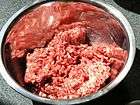
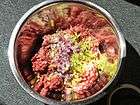


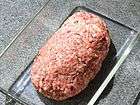
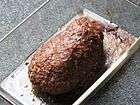
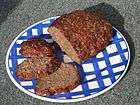
- Argentina
- In Argentina it is usually called Pan de carne. It is typically filled with ham, cheese, carrots or some other vegetable.
- Austria
- The Austrian meatloaf version is called Faschierter Braten. Most of the time it is not filled (e.g., in Germany), but it is wrapped in ham before baking it. Often it is served with mashed potatoes (when warm) or with sauce cumberland (when cold).
- Belgium
- The Belgian version of meatloaf is called vleesbrood (meatbread) in Dutch and pain de viande in French. It is usually served warm and can then be served with various sauces, but can also be eaten cold with a loaf of bread.
- Bulgaria
- Rulo Stefani (Bulgarian: Руло Стефани).[3] The Bulgarian rulo Stefani meatloaf is similar to the Hungarian Stefánia meatloaf, with hard-boiled eggs in the middle.
- Chile
- Chilean meatloaf, known as Asado Aleman (German roasted meat) is a staple of southern Chile cuisine, especially in areas known for having been influenced by the arrival of German settlers during the 18th and 19th century. The most common recipe nowadays consists of ground beef, carrots, sausages, boiled eggs and breadcrumbs, cooked on the oven and normally served with a side-dish of mashed potatoes or rice.
- Cuba
- The Cuban meatloaf is called pulpeta. It is made with ground beef and ground ham, and stuffed with hard boiled eggs, and it is cooked on the stovetop.[4] The dish was brought to public attention, mistakenly referred to as a sausage, in the second episode of the third season of The Cosby Show entitled "Food for Thought".[5]
- Czech Republic
- In the Czech Republic, meatloaf is referred to as sekaná ('chopped'). It is optional to put hard boiled eggs, gherkins, or wienerwurst inside.
- Denmark
- Danish meatloaf is called forloren hare 'mock hare' or farsbrød 'ground-meat bread' and is usually made from a mixture of ground pork and beef with strips of bacon or cubed bacon on top. It is served with boiled or mashed potatoes and brown sauce sweetened with red currant jelly.[6]
- Finland
- Finnish meatloaf is called lihamureke. It is completely based on the basic meatball recipe. The only spices used are salt and pepper. It is not customary to stuff lihamureke with anything. The usual side dish is mashed potatoes, and lihamureke is usually served with brown sauce.
- Germany
- In Germany, meatloaf is referred to as Hackbraten, Faschierter Braten or Falscher Hase 'mock hare'. In some regions it often has boiled eggs inside.[7]
- Greater Middle East
- Kafta or kofta is a similar dish which the mixture can be made into hamburgers and kebabs. It usually has parsley in it.
- Greece
- In Greece, meatloaf is referred to as rolo (Ρολό) and it is usually filled with hard boiled eggs, although several other variations exist.[8]
- Hungary
- Stefania meatloaf (Hungarian: Stefánia szelet)[9] or Stefania slices are a type of Hungarian long meatloaf baked in a loaf pan, with 3 hard boiled eggs in the middle, making decorative white and yellow rings in the middle of the slices.
- Italy
- In Italy, meatloaf is called polpettone and can be filled with eggs or ham and cheese.
- Jewish cuisine
- In Jewish cuisine, meatloaf is called Klops (Hebrew: קלופס) and can be served cold or hot. It is sometimes filled with whole boiled eggs.[10] The source of the word might be German, Klops, meaning meatball.
- Palestine/Lebanon
- "Kafta" or "Kofta" (Arabic: كفتة) is a Middle Eastern version of meatloaf. It is usually beef or lamb mixed with onions, parsley, and various spices flattened into a square loaf and covered in either tomato sauce or tahini sauce. It is baked with the sauces and enjoyed with rice and potatoes (usually baked with the kafta). Kafta or Kofta is also turned into kebabs and grilled during the summer months.
- Macedonia
- Rolat is a similar dish to the chiefly Arab, though also Persian and South-Asian, kofta. Ground beef is rolled and cooked until brown. It can be cooked with vegetables and various sauces.
- Mexico
- It is known as albondigón and has a small size.
- Mongolia
- хучмал (khoochmal) is served with mashed potatoes cooked over the ground meat.[11]
- Philippines
- There is a meatloaf dish called embotido (not to be confused with the Spanish embutido) made of well-seasoned ground pork, minced carrots, sausages, and whole boiled eggs. The meat is molded into a roll with the sausages and hard boiled eggs set in the middle. Another variation of the dish involves wrapping the meatloaf with pork crow or mesentery. It is then wrapped in aluminum foil (historically, banana leaves) and steamed for an hour. The cooked embotido may be stored in freezers. It is usually served fried and sliced for breakfast. In some parts of the Philippines, the embotido is erroneously called "morcon". However, the Filipino morcón itself is another dish though prepared in a similar way.
- Poland
- Called pieczeń rzymska ("Roman roast") or klops is made of ground pork and/or beef, onions and garlic, with obligatory hard boiled egg inside.
- Puerto Rico
- In Puerto Rican cuisine, meatloaf is known as albondigón. Puerto Rican style meatloaf is made with ground pork, beef, turkey, adobo, worcestershire sauce, milk, ketchup, potatoes, red beans, breadcrumb, parsley, with a hard-boiled egg in the middle.
- Romania
- In Romanian cuisine, there is a meatloaf dish called drob, similar to other minced meat dishes in the region like the Bulgarian Rulo Stefani or the Hungarian Stefánia meatloaf, the major difference being that it is always made with lamb organs (or a mixture of lamb organs and pork or veal) and the hard boiled eggs in the centre of the drob are optional.
- South Africa
- One of South Africa's most popular dishes is a form of meatloaf called bobotie. Food in South Africa varies by region, and bobotie is considered a Cape Town or Western Cape dish, but is so popular throughout the country that it is sometimes considered one of South Africa's signature dishes. It is a slightly sweet meatloaf flavored with curry spices, dried apricots and almonds, and is topped with whipped egg and milk topping which when baked on top of the meat filling creates an egg "topping". It arrived in South Africa several hundred years ago from the East Indies and became one of the signature dishes of Cape Town's Cape Malay community.
- Sweden
- Swedish meatloaf is called köttfärslimpa and is usually made from a mixture of ground pork and beef. It is served with boiled or mashed potatoes, brown sauce and lingonberry jam.
- Turkey
In the Turkish cuisine there is a meatloaf with vegetables dish called dalyan köfte.[12]
- United Kingdom
- In the UK there are regional meatloaf dishes known as Haslet.
- United States
- In 2007, meatloaf was voted the seventh-favorite dish in the United States according to Good Housekeeping.
- During the Great Depression, cooking meatloaf was a way to stretch the food budget for families, using an inexpensive type of meat and other ingredients as leftovers; along with spices,[2] it was popular to add cereal grains, bread or saltines to the meatloaf to stretch the meat. The tradition lives on with the merits of producing a lower-fat dish with superior binding and consistency.
- The meatloaf is typically eaten with some kind of sauce or relish. Many of these recipes[13] call for pasta sauce or tomato sauce to be poured over the loaf to form a crust during baking. The tomato-based sauce may be replaced with simple brown gravy or onion gravy, but the meatloaf is prepared in a similar manner. Barbecue sauce, tomato ketchup, or a mixture of both tomato ketchup and mustard may also be used. American meatloaf may be garnished with plain ketchup or a "meatloaf sauce" consisting of ketchup and brown sugar mixed.
- Another variety of meatloaf is prepared by frosting it with mashed potatoes, drizzling it with a small amount of butter, and browning in the oven.
- The meatloaf is normally served warm as part of the main course, but can also be found sliced as a cold cut. Meatloaf can also be considered a typical comfort food and is served in many diners and restaurants today.
- Vietnam
- The Vietnamese meatloaf version is called giò. It is boiled rather than baked or smoked. There are many versions of giò that differ by the ingredients used.
See also
- Cheeseburger
- Groaty pudding
- Haggis
- Hamburger
- List of beef dishes
- Meatball
- Meat pie
- Nut roast
- Nutraloaf, type of food sometimes served in some US prisons
- Red pudding
- Salisbury steak
- Swiss steak
References
| Wikimedia Commons has media related to Meatloaves. |
| Wikibooks has a book on the topic of: Cookbook:Meatloaf |
- 1 2 Zeldes, Leah A. (2009-09-02). "Eat this! Meatloaf, easy comfort". Dining Chicago. Chicago's Restaurant & Entertainment Guide, Inc. Retrieved 2010-08-03.
- 1 2 3 Meatloaf history in US
- ↑ за руло Стефани
- ↑ "Cuban Meatloaf recipe - How to Make Pulpeta Cubana". Tasteofcuba.com. Retrieved 2014-08-09.
- ↑ "The Cosby Show". TV.com. Retrieved 2014-08-09.
- ↑ (Danish) Min far's forloren Hare, FÅS IKKE BEDRE
- ↑ (German) Omas Rezept für falscher Hase
- ↑ (Greek) Ρολό κιμά με γέμιση αυγά, καρότο, πιπεριά και μπέικον
- ↑ Stefánia meatloaf
- ↑ Samuel Cohen. המטבח היהודי של שמוליק כהן [Shmoolik Cohen's Jewish Cuisine] (in Hebrew). Modan. p. 82.
- ↑ http://www.hool.mn/?dazo=foodfull&foodid=111&MenuID=1
- ↑ Murat Yegul (September 2010). The Secrets of Hearty Turkish Home Cooking. AuthorHouse. pp. 3–. ISBN 978-1-4520-4794-2.
- ↑ Meatloaf

